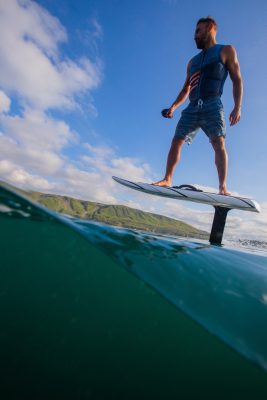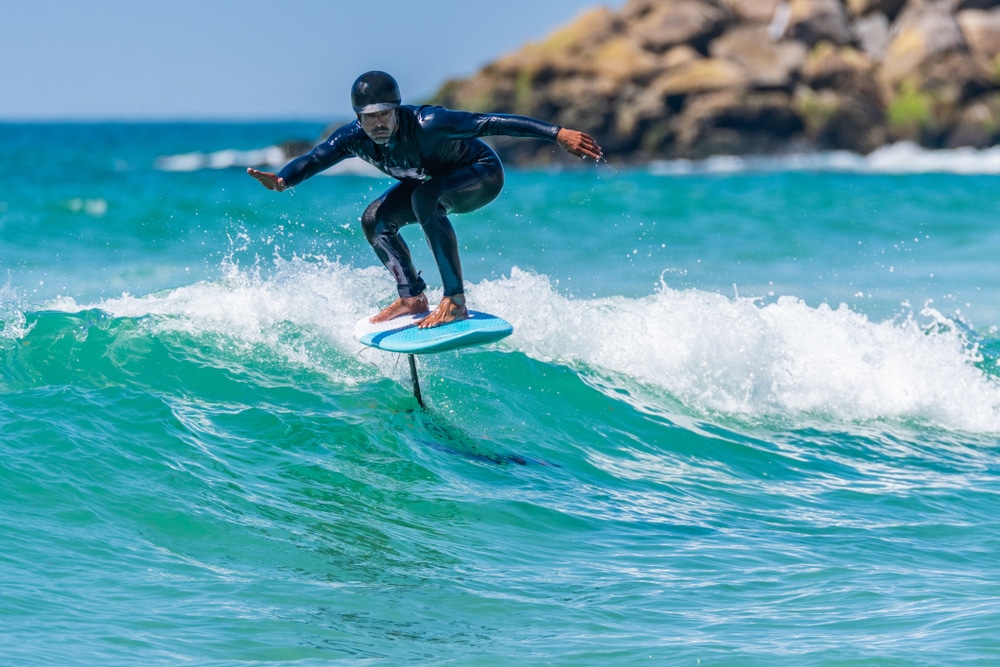Still a rarity in our waters, you can already see them gliding over the surface of the water in Hawaii, California and other famous surf spots around the world: We’re talking about e-foils. The sensational sport is equally interesting for beginners and surf pros – and is slowly but surely making its way into Europe. We take a look at what’s behind the new trend and, above all, how you too can try out the hip sport.
How it works
When they are in the water, e-foils actually look like normal surf or kiteboards. But once they start to move and gain speed, an amazing difference becomes apparent: the surfer takes off on the board and floats above the surface of the water at a height of half a meter. Why is it that people can glide so effortlessly over the water on the e-foil and get such a speed on top of that – and without any waves or wind?
An e-foil has two very crucial components that ensure that the board can take off:
- Hydrofoil: The part of the device, actually called foil or hydrofoil , is attached where a classic surfboard has its center fin. It consists of a mast, front and rear wings and possibly a propeller. A popular material for this is full carbon fiber, as it is both lightweight and extremely durable.
- Electric motor: Inside the board is the motor. An electric battery is installed at the rear end of the board, which not only delivers maximum performance, but is also completely protected from salt water and other external influences.
But why does the foil take off? The wing generates a vacuum above a certain speed; this creates a lift. This ensures that the E-Foil detaches itself from the surface of the water and floats over it. The surfers don’t have to paddle: The electric motor, controlled by a small remote control, drives the board and ensures that it goes into gliding flight.
The advantages of e-foiling

Compared to classic surfing and other variants of surfing, e-foiling has some convincing advantages. While surfers are dependent on the weather and wave conditions, e-foilers can glide over the water (almost) anytime and anywhere.
Surfers know it: The swell direction is not right and the wind is too strong. Windsurfers and kitesurfers, on the other hand, sometimes suffer from the light winds, which make it impossible to get a speed that is also fun. None of these problems exist with the E-Foil. The electric motor ensures that the foil floats over the sea even when the waves are not surfable for the normal surfers. And that’s not all: it also opens up completely new surf spots, for example on lakes and rivers. And e-foilers don’t have to pay so much attention to the tides either, unlike surfers. With e-foiling, surfers are very flexible and can also spontaneously take a short session at low tide.
E-Foiling Spots in Europe
In Europe, there are already some spots where you can see the e-foils flying over the water more and more often. More and more schools and rental companies are also offering courses.
In the Netherlands, the trend sport is already extremely popular. For example, you can glide through the water in Amsterdam in the Nieuwe Lake or in the immediate vicinity of the IJsselmeer with the e-foil. And you can also see more and more e-foilers flying around at various spots on the North Sea.
If you want to try e-foiling on vacation, you will already find some spots in Italy, for example. In Gargano on the Adriatic Sea, you get a real beach feeling. The courses there take place on the open sea, but are still suitable for beginners.
And there are already a handful of spots in Germany where you can rent e-foils or take part in a training course. One of them is in Bremerhaven. The E-Foil rental also offers courses for individuals or groups of two, in which the participants float over the Weser or over the North Sea at Cuxhaven or Wremen.
Also suitable for beginners
We find flying with the e-foil to be the easiest way to surf. With the small waterproof remote control, the rider has it in his own hands how fast he wants to ride the foil. The foils from the premium manufacturer Lift, for example, drive for up to two hours at a top speed of 40 km/h.
We highly recommend beginners to take an introductory course. And even for more experienced surfers, this can make sense. E-foiling is very different from normal surfing. In this way, the course participants not only learn the basics that are needed to take off, but also general netiquette in the water. And material care also needs to be learned – after all, e-foils are not exactly the cheapest sports equipment. A good model costs around 12,000 €. Considering the high-quality technology built into the boards, this price is justified – but with the high price comes a high level of responsibility. The more carefully the equipment is handled, the longer it will last.
E-foiling – new sport, new challenge
E-foiling is a trend that is here to stay! Recreational and professional athletes who love the water and new challenges will be thrilled by this sport. The increasing popularity also leads to more and more new e-foil spots with rental shops and schools. This means that beginners and interested parties can also try out the sport without immediately investing in one of the high-priced e-foils. But beware: We’ve heard that e-foiling can be really addictive!


